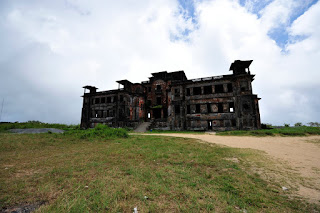
To be honest, the reason why I wanted to visit Mandalay was to attend a Moustache Brothers show. The Moustache Brothers are a subversive group of Burmese comedians, who for years performed at weddings and village shows. Until 1996, when ‘Moustache Number One’ Par Par Lay was arrested and cousin Lu Zaw were arrested after telling contoversial jokes at an outdoor performance in front of Aung San Suu Kyi’s house in Yangon, and sentenced to 7 years forced labour. Par Par Lay’s freedom became a pet cause for several celebrities , culminating in his mention in ‘About a Boy’. After his lengthy stint, Par Par Lay was arrested twice more, as leader of the troupe. Amazingly, Lu Maw, Moustache Number Two and the only English speaker of the group, was never arrested. Following these events, the Moustache Brothers were banned from performing outdoors or at public events. Nowadays, their performance takes place at 8.30 nightly at their home in downtown Mandalay. Burmese are forbidden to assist; the show is for tourists only. However, a crowd of Burmese people can often be seen hanging around the entrance door...

After a dinner of the very best chapati and veggie curry, we arrived at the Moustache Brothers home half an hour early and were greeted by Lu Maw. A fit 60 year old man wearing a singlet an a longyi, and puffing away on Burmese cigars, Lu Maw was instantly friendly. The show was performed in the Brothers’ living room, on a rustic wooden stage surrounded by a dozen plastic chairs. Lu Maw said we could do ‘anything you want, eat, drink beer, smoke... I am 60 but look maybe 22, 23 because I smoke 24 hours a day!’. After showing us articles about the troupe on several magazines he presented the 1996 Italian issue of Lonely Planet, with his wife’s picture on the cover....’this is my wife! She is pin-up, cover girl! I am 60, she is 41... I am... how do you say it? Bed-snatcher? Ah, that’s right... cradle snatcher! Sugar Daddy!’.
The show started shortly afterwards, with an audience of 11 sipping Myanmar beer, eating noodles and puffing on cigars offered by Lu Maw. The room was small, with wooden walls and concrete floors. Lu Maw stood on the stage talking into a creaky microphone, surrounded by puppets (the other brothers are puppeteers). A number of wooden boards with therms as diverse as ‘sarong’, ‘turban’ and ‘KGB’ were used by Lu Maw, who pointed at the relative term to aid the understanding of non-English speaking audience, a bit like makeshift subtitles. The show started with Lu Maw entertaining the audience with jokes, along the lines of ‘....don’t steal anything in Myanmar! The government doesn’t like competition!’ and ‘....I had to go to Thailand to visit the dentist! In Myanmar I can’t open my mouth’. He kept referring to the government police as KGB (as well as Stasi, Sismi and MI5, in honour to the multicultural audience). He explained this KGB knows ‘everything you do’, along the lines of the Orwellian Psychopolice. He had a point; a favourite Burmese joke is that Orwell wrote three books about Myanmar, Burmese Days, Animal Farm and 1984.

The show continued with Par Par Lay appearing in handcuffs, with a sign around his neck saying ‘Jailbird’ and ‘blacklisted’; sarcastically true. The show moved to the an interpretation of the traditional a-nyent-pye, a Burmese vaudevillian show with dancing and music with the background of Lu Maw’sketches and jokes. The famous pin-up wife, in reality an accomplished dancer, came on stage demonstrating some figures of Burmese dancing. In a particularly difficult one, the lady was jumping and landing on her knees, with Lu maw saying ‘I want to see the blood....not just the bruise’. The show was a family affair; as well as Par Par Lay, Lu Zaw, and Lu Maw’s wife, also a sister and a sister in law participated. Par Par Lay demonstrated traditional Shan, Chinese, Indian and Thai dancing, then his sister explained the audience how to wear the traditional 8-cubit longyi that was the court’s prerogative. She kicked the train in the air, then skillfully grabbed it and tucked it at the waist. Lu Maw instructed the audience to capture the moment on photo, then went around mocking those who didn’t get it be saying ‘...your camera is made in China... Three dollars!’.


The last sketch was a big dance off with 6 characters; Ozi drum (whatever that is), court page, monkey, ogre, alchimist and chamberlain, performed by the various members of the family. The show was entertaining and interesting. Lu Maw’s sense of humour was rather slapstick, and he seemed to be pleasing most of the audience. He earlier explained that he had to simplify his sense of humour to perform for tourists, who may be unaware of political or historical references he used to make. Anyway, the show for me was only an excuse. I was proud of meeting these men, who represent a voice of dissent in a country where freedom of speech is nothing more than a distant dream.














































